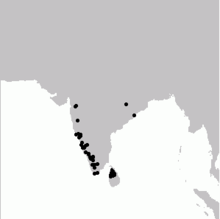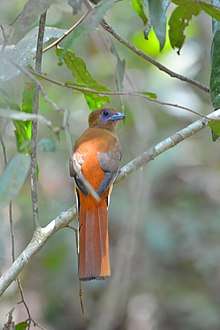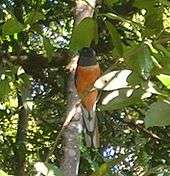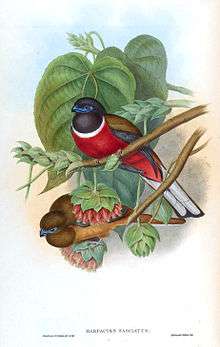Malabar trogon
The Malabar trogon (Harpactes fasciatus) is a species of bird in the trogon family. It is found in the forests of Sri Lanka and peninsular India. In India it is mainly found in the Western Ghats, hill forests of central India and in parts of the Eastern Ghats. They are insectivorous and although not migratory, may move seasonally in response to rain in hill forest regions. Like in other trogons, males and females vary in plumage. The birds utter low guttural calls that can be heard only at close quarters and the birds perch still on a branch under the forest canopy, often facing away from the viewer making them easy to miss despite their colourful plumage.
| Malabar trogon | |
|---|---|
.jpg) | |
| Male H. f. malabaricus | |
| Scientific classification | |
| Kingdom: | Animalia |
| Phylum: | Chordata |
| Class: | Aves |
| Order: | Trogoniformes |
| Family: | Trogonidae |
| Genus: | Harpactes |
| Species: | H. fasciatus |
| Binomial name | |
| Harpactes fasciatus (Pennant, 1769) | |
 | |
| Synonyms | |
|
Harpactes malabaricus | |
Description

Like most other trogons, these birds are brightly coloured and sexually dimorphic. The male has a slaty black head and breast with a white border to the black bib separating it from the crimson on the underside. The back is olive-brown to chestnut. The wing coverts are black with fine white vermiculations. They have 12 tail feathers that are graduated.[2] The central tail-feathers are chestnut with a black tip, with the second and third pairs from the middle having more black than chestnut. The outer three pairs have long white tips. The female lacks the contrasting black and crimson and has only a slightly darker head and breast that shades into the olive brown on the back while the crimson of the underside of the male is replaced by ochre. In both sexes, the beak is bluish as is the skin around the eye. The iris is dark brown and the feet are pale bluish.[3][4] The nostrils are covered by tufts of filoplumes. The feet are heterodactyl, a feature unique to the trogons, with the digits I and II facing back and digits III and IV pointing forward.[5] In most birds I, II and III face forward while IV faces back and in zygodactyly II and III face forward while I and IV face backwards.[6]
Several populations have been named. The central Indian subspecies legerli, named by Walter Norman Koelz on the basis of a single specimen obtained from the foot of Mahendra Giri in Orissa is not always recognized,[7] but said to be slightly larger, longer winged and brighter than malabaricus of the Western Ghats.[8] The nominate race found in the central wet zone of Sri Lanka is smaller and the upperparts are brighter.[3]
Behaviour and ecology
These birds usually perch still, especially when alarmed[9] and will sometimes clinging laterally to branches. When calling they sometimes raise and lower their tail. The call is a series of guttural or purring notes. The song of the male is a series of percussive kyau calls. The breeding season in India is mainly February to May (before the Monsoons) while it is March to June in Sri Lanka.[3]

When they sit still, the appear hunched. The Hindi name used by hunters is kafni churi and refers to the hunched neckless appearance as if dressed in a fakir's kafni (robe). The Marathi name is karna while it is called kakarne hakki in Kannada[2] In Kerala it is known as theekakka (literally "fire-crow").[10][11] In Sri Lanka, it is known as loha wannichcha.
Malabar trogons feed exclusively on insects and fruits have not been noted in their diet unlike in the New World trogons.[4] Seeds have however been reported in the diet of Sri Lankan specimens.[11] In the forests of Sri Lanka, they are often found in mixed-species foraging flocks[12] where they may sometimes be subject to kleptoparasitism by drongos.[13] A study in Kerala found that they foraged mainly at 5 to 10 m with females tending to forage lower within the canopy. When foraging on bark, they propped themselves using their tail like woodpeckers, especially on decaying tree stumps. They sometimes descend to the ground and search for insects under leaf litter. They will sometimes fly and try to flush prey and then hover to pick up prey. They may also hang upside down to reach prey on vertical tree surfaces. Prey are often mashed or struck on a branch between the mandibles before feeding on them or prior to feeding young. The contact call is a series of about five low intensity que while these were of higher intensity in territorial fights. The alarm call is a churrrr and a similar call is also delivered prior to roosting.[10] Although their flight is fast, they are reluctant to fly. In the Nilgiri hills they are altitudinal migrants and are found in the higher reaches only during summer.[14]

The nest is made in rotting trees or stumps that are easy to carve and pulverize using their bills. The male and female take turns to excavate the nest using their bills. It may take about a month to excavate the nest. The floor is made out of the wood powder and no extra lining is added. Two eggs were seen to be the normal clutch in a study in Kerala although older works suggest that the typical clutch is of three eggs.[15] The eggs are laid with a gap of two days and incubated by both males and females with the females usually incubating at night. The incubation period is about 19 days. The hatchlings are fed mainly caterpillars for the initial period and later provided bugs, flies and orthopterans. The parents do not remove the excreta of the nestlings from the nest. The adults continue to feed the fledged juveniles for nearly 5 to 6 months. They are socially monogamous with pair bonds lasting more than a season.[10]
Sri Lankan birds have been seen to plunge into water from an overhanging branch to bathe.[16]
A species of endoparasitic cestode, Triaenorhina burti has been described from the species.[17]
Status
The species is becoming rarer in many parts of India and it is thought to be sensitive to forest fragmentation.[18] Salim Ali noted it as being common in some areas of the Surat Dangs where it is now rare. One of his records is from Ajwa in Vadodara district which is believed to be a typographical error for Ahwa further south.[19] Tickell collected specimens from Dampara in Dholbhum.[20]
References
- BirdLife International (2012). "Harpactes fasciatus". IUCN Red List of Threatened Species. 2012. Retrieved 26 November 2013.CS1 maint: ref=harv (link)
- Jerdon, TC (1862). The Birds of India. Volume 1. Military Orphan Press, Calcuttabook. pp. 201–202.
- Rasmussen, PC & JC Anderton (2005). Birds of South Asia: The Ripley Guide. Volume 2. Smithsonian Institution and Lynx Edicions. p. 261.
- Blanford, WT (1895). The Fauna of British India. Birds. Volume 3. Taylor and Francis, London. pp. 199–200.
- Mayr, Gerald (2003). "On the phylogenetic relationships of trogons (Aves, Trogonidae)" (PDF). J. Avian Biol. 34: 81–88. doi:10.1034/j.1600-048X.2003.03042.x.
- Botelho, João Francisco; Smith-Paredes, Daniel; Nuñez-Leon, Daniel; Soto-Acuña, Sergio; Vargas, Alexander O. (7 August 2014). "The developmental origin of zygodactyl feet and its possible loss in the evolution of Passeriformes". Proceedings of the Royal Society of London B: Biological Sciences. 281 (1788): 20140765. doi:10.1098/rspb.2014.0765. ISSN 0962-8452. PMC 4083792. PMID 24966313.
- Ali,Salim (1949). "The validity of Harpactes fasciatus legerli (Koelz)". J. Bombay Nat. Hist. Soc. 48 (4): 806–808.
- Koelz, Walter (1939). "New birds from Asia, chiefly from India". Proceedings of the Biological Society of Washington. 52: 61–82.
- Goodale, Eben & Sarath W. Kotagama (2008). "Response to conspecific and heterospecific alarm calls in mixed-species bird flocks of a Sri Lankan rainforest". Behavioral Ecology. 19 (4): 1–8. doi:10.1093/beheco/arn045.
- Varghese, AP (2002). Ecology and behaviour of Malabar Trogon Harpactes fasciatus malabaricus. Doctor of Philosophy Thesis, Mahatma Gandhi University, Kottayam.
- Layard, EL (1853). "Notes on the Ornithology of Ceylon, collected during an eight years' residence on the Island". The Annals and Magazine of Natural History. 12 (69): 165–176. doi:10.1080/03745485709495020.
- Kotagama, Sarath W & Eben Goodale (2004). "The composition and spatial organisation of mixed-species flocks in a Sri Lankan rainforest" (PDF). Forktail. 20: 63–70.
- Sathischandra, SHK; E.P. Kudavidanage; E. Goodale & S.W. Kotagama (2009). "Foraging ecology of Crested Drongos (Dicrurus paradiseus lophorhinus) in the Sinharaja Reserve" (PDF). Siyoth. 2 (1): 9–11.
- Zarri, A.A. & A.R.Rahmani (2005). "Malabar Trogon in the Nilgiris Upper Plateau, Tamil Nadu". J. Bombay Nat. Hist. Soc. 102 (1): 116.
- Waite, WE (1920). "The Picarian Birds and Parrots of Ceylon". Spolia Zeylanica: 197–272.
- Ali S, Ripley SD (1983). Handbook of the birds of India and Pakistan. 4 (2nd ed.). Oxford University Press. pp. 61–63.
- Georgiev BB, Gibson DI (2006). "Description of Triaenorhina burti n. sp. (Cestoda: Paruterinidae) from the Malabar trogon Harpactes fasciatus (Pennant) (Aves: Trogoniformes: Trogonidae) in Sri Lanka". Systematic Parasitology. 63 (1): 53–60. doi:10.1007/s11230-005-9002-x. PMID 16699928.
- Raman TR (2006). "Effects of Habitat Structure and Adjacent Habitats on Birds in Tropical Rainforest Fragments and Shaded Plantations in the Western Ghats, India". Biodiversity and Conservation. 15 (4): 1577–1607. doi:10.1007/s10531-005-2352-5.
- Trivedi, Pranav & VC Soni (2006). "Significant bird records and local extinctions in Purna and Ratanmahal Wildlife Sanctuaries, Gujarat, India" (PDF). Forktail. 22: 39–48. Archived from the original (PDF) on 26 February 2012.
- Beavan, R. C (1869). "Additional Notes on various Indian Birds". Ibis. 11 (4): 403–426. doi:10.1111/j.1474-919X.1869.tb06894.x.
Other sources
- Inglis,CM (1944) The nesting of the Malabar Trogon. Jour. Bengal Nat. Hist. Soc. 18:101.
External links
| Wikimedia Commons has media related to Harpactes fasciatus. |
| Wikispecies has information related to Harpactes fasciatus |
